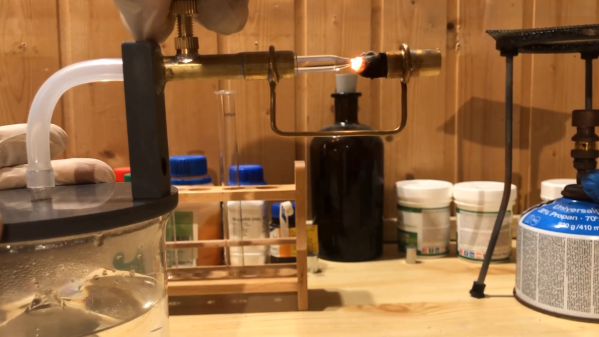With our mass-produced butane lighters and matches made in the billions, fire is never more than a flick of the finger away these days. But starting a fire 200 years ago? That’s a different story.
One method we’d never heard of was Döbereiner’s lamp, an 1823 invention by German chemist Johann Wolfgang Döbereiner. At first glance, the device seems a little sketchy, what with a tank of sulfuric acid and a piece of zinc to create a stream of hydrogen gas ignited by a platinum catalyst. But as [Marb’s Lab] shows with the recreation in the video below, while it’s not exactly as pocket-friendly as a Zippo, the device actually has some inherent safety features.
[Marb]’s version is built mainly from laboratory glassware, with a beaker of dilute sulfuric acid — “Add acid to water, like you ought-er!” — bathing a chunk of zinc on a fixed support. An inverted glass funnel acts as a gas collector, which feeds the hydrogen gas to a nozzle through a pinch valve. The hydrogen gas never mixes with oxygen — that would be bad — and the production of gas stops once the gas displaces the sulfuric acid below the level of the zinc pellet. It’s a clever self-limiting feature that probably contributed to the commercial success of the invention back in the day.
To produce a flame, Döbereiner originally used a platinum sponge, which catalyzed the reaction between hydrogen and oxygen in the air; the heat produced by the reaction was enough to ignite the mixture and produce an open flame. [Marb] couldn’t come up with enough of the precious metal, so instead harvested the catalyst from a lighter fluid-fueled hand warmer. The catalyst wasn’t quite enough to generate an open flame, but it glowed pretty brightly, and would be more than enough to start a fire.
Hats off to [Marb] for the great lesson is chemical ingenuity and history. We’ve seen similar old-school catalytic lighters before, too.
Continue reading “Lighting Up With Chemistry, 1823-Style” →
 It’s always a party when the good folks from Adafruit stop by the Hack Chat, and we expect no less than that this time around. It’s hard to predict where the conversation will go when [LadyAda], [pt], and [Scott] roll in, but we strongly suspect it’ll center on what’s new in the world of CircuitPython.
It’s always a party when the good folks from Adafruit stop by the Hack Chat, and we expect no less than that this time around. It’s hard to predict where the conversation will go when [LadyAda], [pt], and [Scott] roll in, but we strongly suspect it’ll center on what’s new in the world of CircuitPython.















